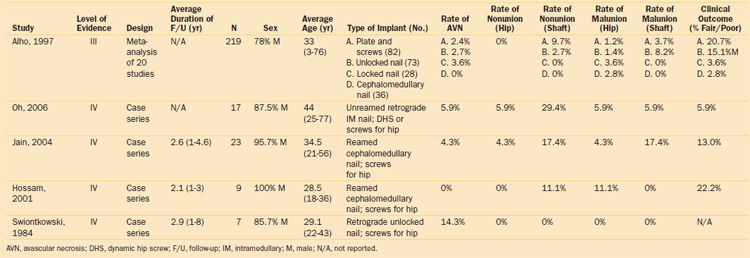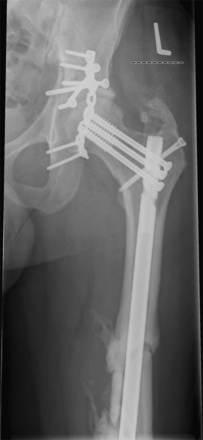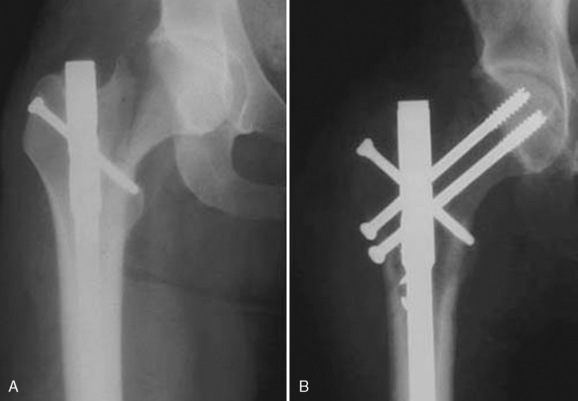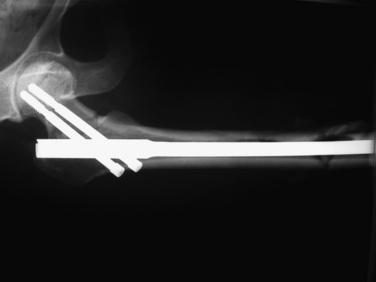8 Combined Fractures of the Hip and Femoral Shaft
Ipsilateral fractures of the femoral neck and shaft are rare injuries caused by high-energy trauma. This unusual injury pattern is most commonly seen in younger patients involved in motor vehicle accidents.1,2 The incidence in the literature ranges between 2.5% and 6%.3–6 This complex high-energy injury is easily missed and can cause significant morbidity. Numerous management options are described in the literature. The definitive treatment is often based on the surgeon’s experience. We provide an overview and look at the clinical evidence regarding the management of combined femoral neck and shaft fractures to improve patient outcomes (Fig. 8-1).
Incidence
Combined femoral neck and shaft fractures are rare injuries. The incidence in the literature ranges between 2.5% and 6%.3–6 Alho conducted a systematic review of 65 studies published between 1970 and 1996 that incorporated 722 cases of ipsilateral hip and shaft fractures.1 This review represents the largest summary of case series reported in the literature. He identified 10 studies (240 fractures) that included useful demographic data. This injury typically occurred in young patients (mean age, 33 years) and resulted from a high-energy mechanism (85% motor vehicle accidents). Only 1% of the cases in this review occurred in elderly patients. Approximately 18% of the femoral shaft fractures were reported as open, with a large number of comminuted fractures (i.e., 42% were Winquist type III or IV).7 Most shaft fractures occurred in the middle third of the femur (72%). For hip fractures, Alho reported that the majority consisted of femoral neck fractures (61%), and the rest were trochanteric fractures. Shuler et al reported on 52 cases of hip fracture with femoral shaft fracture and found 90% to be femoral neck fractures.8
Accurate diagnosis and prompt treatment are vital to avoid significant morbidity. Occult femoral neck fractures are easily missed when associated with other distracting injuries9 (Fig. 8-2).
Mechanism of Injury and Pathophysiology
The mechanism of injury is an axial force applied along the femur. This usually occurs as the occupant’s knee strikes the dashboard of a vehicle. If the hip is adducted when this force is applied, the resulting injury to the hip usually will be a dislocation or an acetabular fracture. If the hip is in abduction, this will produce a femoral neck and shaft fracture.10 Shuler et al reported that these hip fractures all tended to extend into the inferomedial neck regardless of the fracture type (i.e., midcervical, basicervical, or pertrochanteric).8 The extension of the fracture into the inferomedial neck (i.e., femoral calcar) makes it prone to displacement with weight bearing. Given the rarity of this injury (i.e., occurring in less than 9% of all femoral shaft fractures), there are no large series reported in the literature.1–12 Nearly 60 different implant combinations have been described for this fracture pattern.13,14
Initial Diagnosis and Assessment
The initial management of a patient presenting with a history of a significant high-energy mechanism is assessment according to the Advanced Trauma Life Support protocol. Once the patient is stabilized, initial radiographs should be performed to confirm injuries suspected. All patients with femoral shaft fractures resulting from a high-energy mechanism (especially motor vehicle accidents) should undergo a computed tomography (CT) scan of the ipsilateral hip before definitive fixation.12
Tornetta et al conducted a level II study on the effectiveness of a radiographic protocol to detect nondisplaced hip fractures in patients with femoral shaft fractures.11 A standard protocol of CT scan, dedicated internal rotation hip radiographs, and lateral intraoperative fluoroscopic hip images for all femoral shaft fractures was instituted, and the rate of missed hip fractures was recorded. This protocol significantly decreased the rates of missed hip fractures (57% before institution of the protocol versus 6.3% afterward).
Management Options and Controversies
Many investigators contend that the complications of the femoral neck trump those of the femoral shaft. These investigators suggest that avascular necrosis is the most significant complication, and therefore the femoral neck fracture should be treated first.15,16 Others suggest that the femur should be treated initially to allow for ease of closed reduction of the femoral neck fracture.7,8,17
A spectrum of different hip fractures has been reported with this injury pattern. The position of the hip (degree of abduction) at the time of injury has been suggested as the determinant of the pattern of hip fracture produced.9 Hip fractures vary from intertrochanteric fractures to different types of intracapsular neck fractures. As a result, many different implants and implant combinations have been used to treat this combination of fractures.
Implant designs have evolved and changed over the time periods of many of the retrospective case series reported in the literature (Table 8-1). For example, the antegrade femoral intramedullary nail has evolved from the unlocked (Küntscher) nail, to the first-generation locked nail, to the second-generation cephalomedullary (or reconstruction) locked nail, and finally to the intramedullary hip screw device (Fig. 8-3).
Table 8-1 Studies Examining Implants Used for Femoral Shaft Fixation in Ipsilateral Hip and Femoral Shaft Fractures

Stay updated, free articles. Join our Telegram channel

Full access? Get Clinical Tree











